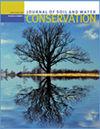Infiltration within native prairie vegetative strips embedded in row crop fields across Iowa
IF 2.6
4区 农林科学
Q2 ECOLOGY
引用次数: 0
Abstract
The integration of native prairie vegetative strips into row crop agriculture is a promising conservation strategy that has gained momentum in adoption rates throughout the US Midwest. Previous studies have shown that prairie strip establishment can lead to several positive soil and water quality outcomes, such as reductions in surface runoff and nutrient and sediment exports. However, the impacts of prairie strips on soil infiltration are not well known. In this study, the Cornell Sprinkle Infiltrometer system was used to measure differences in field-saturated infiltration rate between prairie strip and row crop treatments at six sites across Iowa after five to seven years since prairie strip establishment. Additionally, approximate sorptivity was calculated to compare trends in early infiltration between the two treatments at each site. Measurements were taken over a two-year span during summer and fall testing periods. Further, at two additional prairie strips sites, a separate approach using the tension infiltrometer generated hydraulic conductivity data for prairie strip and row crop treatments at 3, 4, and 14 years since prairie strip establishment. Differences between prairie strip and row crop were mostly undetected across nearly all sites in field-saturated infiltration rate and saturated hydraulic conductivity at 5 to 7 and 14 years after prairie strip establishment, respectively. However, at one site, saturated hydraulic conductivity was significantly greater within prairie strip than row crop, and at another, field-saturated infiltration rate was 3.6 times greater in prairie strip than row crop. Therefore, considering trends from both prairie strip age and infiltration testing method groups, differences in saturated infiltration capacity between prairie strip and row crop appear to be related to site-specific characteristics like soil texture, row crop tillage, and soil organic matter, especially at earlier stages of prairie strip establishment. Comparing trends in sorptivity approximations between the two treatments determined that prairie strips had 26% and 38% greater early infiltration than row crops during fall testing periods, but no treatment difference was found in the summer testing period. Since significant results were mostly limited to the fall, a combination of initial soil moisture and surface roughness disparities between treatments likely explain the observed treatment differences in approximate sorptivity. Within prairie strips, greater early infiltration relative to row crops delays and limits surface runoff generation. Therefore, this study suggests that a row crop field containing prairie strips will generate less surface runoff than a comparable 100% row crop field during a given rainfall event at the end and potentially beginning of the annual corn ( Zea mays L.) and soybean ( Glycine max [L.] Merr.) growing season in Iowa. By improving early infiltration and subsequently limiting runoff generation and sediment transport, prairie strips can be a valuable soil and water conservation tool.爱荷华州各地行作田中嵌入的原生草原植被带的渗透情况
将原生草原植被带与连作农业相结合是一种很有前景的保护策略,在美国中西部地区的采用率越来越高。先前的研究表明,草原带的建立可带来一些积极的土壤和水质效果,如减少地表径流以及养分和沉积物的输出。然而,人们对草原带对土壤渗透的影响还不甚了解。在这项研究中,康奈尔洒水渗透仪系统被用来测量爱荷华州六个地点的草原带和连作作物处理之间的田间饱和渗透率差异,这些处理都是在草原带建立五到七年之后进行的。此外,还计算了近似吸水率,以比较每个地点两种处理之间的早期渗透趋势。测量时间跨度为两年,分别在夏季和秋季测试期间进行。此外,在另外两个燎原带地点,使用张力渗透仪的单独方法生成了燎原带和行列作物处理在燎原带建立后 3 年、4 年和 14 年的水力传导率数据。几乎所有地点在草原带建立后 5 至 7 年和 14 年的田间饱和入渗率和饱和导流率方面都没有发现草原带和连作作物之间的差异。然而,在一个地点,草原带的饱和水力传导率明显高于间作作物,而在另一个地点,草原带的田间饱和入渗率是间作作物的 3.6 倍。因此,考虑到草原带年龄组和渗透测试方法组的趋势,草原带和连作作物之间饱和渗透能力的差异似乎与土壤质地、连作作物耕作和土壤有机质等特定地点特征有关,尤其是在草原带建立的早期阶段。通过比较两种处理的吸水率近似值趋势,可以确定在秋季测试期间,草原带的早期渗透率分别比行列作物高出 26% 和 38%,但在夏季测试期间没有发现处理差异。由于有意义的结果主要局限于秋季,因此处理间初始土壤湿度和表面粗糙度的差异很可能解释了所观察到的处理间近似吸水率的差异。在草原带中,与连作作物相比,更多的早期渗透延迟并限制了地表径流的产生。因此,这项研究表明,在爱荷华州一年生玉米(Zea mays L.)和大豆(Glycine max [L.] Merr.)生长季节的末期和可能的初期,在特定降雨情况下,含有草原带的连作农田产生的地表径流将少于可比的 100% 连作农田。通过改善早期渗透,进而限制径流的产生和沉积物的迁移,草原带可以成为一种宝贵的水土保持工具。
本文章由计算机程序翻译,如有差异,请以英文原文为准。
求助全文
约1分钟内获得全文
求助全文
来源期刊
CiteScore
4.10
自引率
2.60%
发文量
0
审稿时长
3.3 months
期刊介绍:
The Journal of Soil and Water Conservation (JSWC) is a multidisciplinary journal of natural resource conservation research, practice, policy, and perspectives. The journal has two sections: the A Section containing various departments and features, and the Research Section containing peer-reviewed research papers.

 求助内容:
求助内容: 应助结果提醒方式:
应助结果提醒方式:


